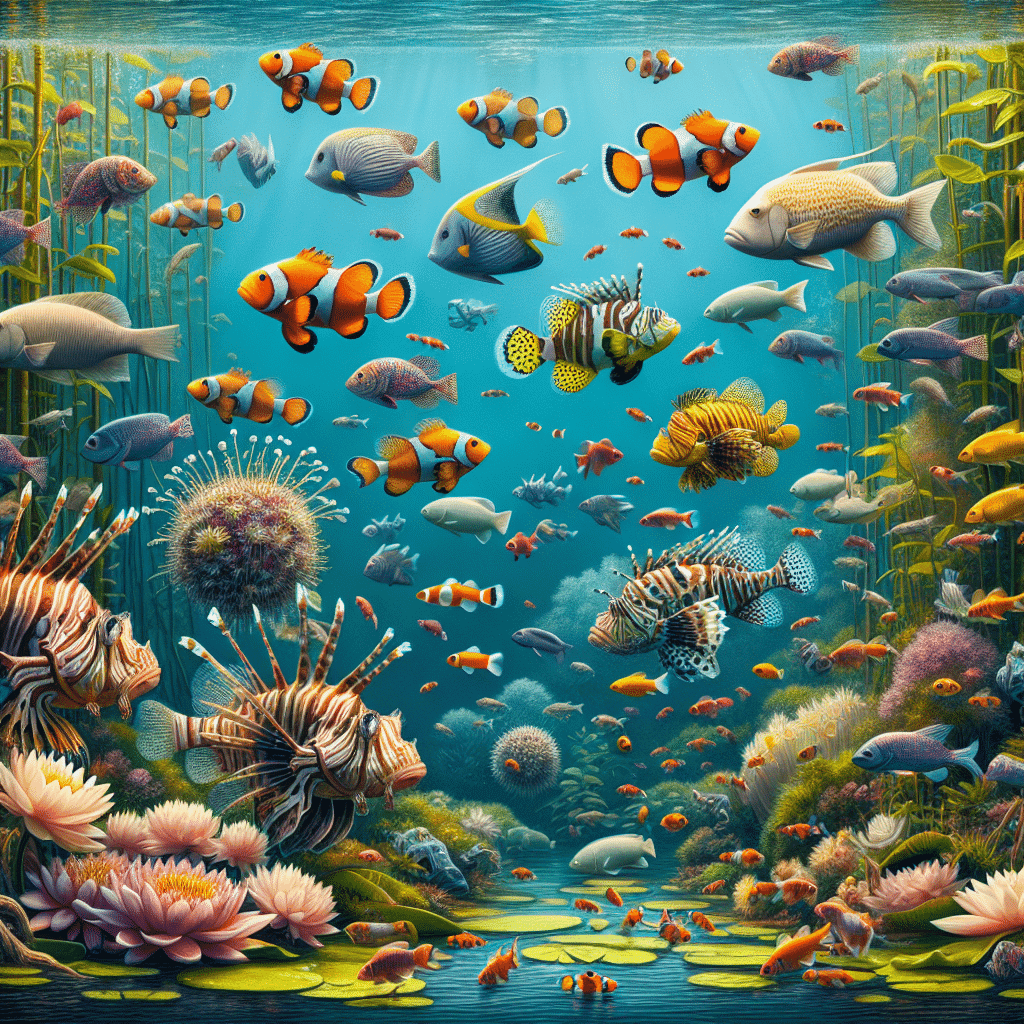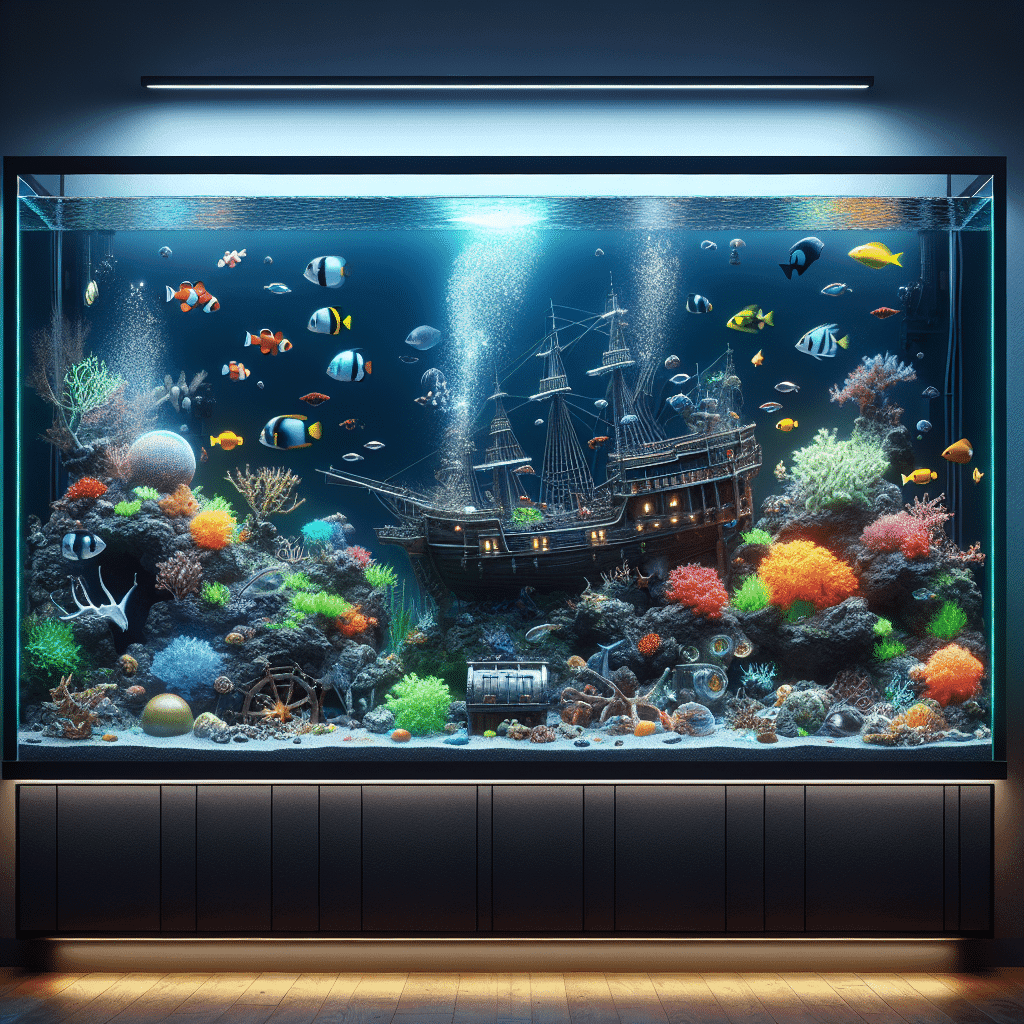Understanding Fish Salinity Tolerance
As a fish tank and reef tank hobbyist, understanding how salinity affects fish is essential, especially when considering the topic of keeping saltwater fish in freshwater. This section explores the incredible adaptations of certain fish species and the fascinating mechanisms they use to survive in varying salinity levels.
Euryhaline Fish Species
Some fish are true champions of adaptability, and these are known as euryhaline species. Euryhaline fish can thrive in a wide range of salinity levels—from freshwater to brackish and even marine waters. Notable examples include salmon, eels, red drum, striped bass, and flounder. These fish can adjust to different salinities at various stages of their life cycles, making them unique in the aquatic world Scientific American.
| Fish Species | Salinity Range |
|---|---|
| Salmon | Fresh to Marine |
| Eels | Fresh to Marine |
| Red Drum | Fresh to Brackish |
| Striped Bass | Fresh to Marine |
| Flounder | Fresh to Marine |
For euryhaline fish, a gradual acclimation period is often necessary to tolerate significant changes in salinity. This ability makes them particularly interesting for hobbyists who want to explore diverse aquatic environments.
Osmoregulation in Fish
Osmoregulation is the process by which fish maintain the balance of salts and water in their bodies. In saltwater fish, the challenge is to replace water lost through osmosis, a process where water moves from areas of low salt concentration to areas of high salt concentration. To survive in increasingly saline oceans, these fish evolved mechanisms to retain water and expel excess salts Scientific American.
In contrast, freshwater fish face the opposite challenge. Since their bodies have a higher salt concentration than the surrounding water, they experience water influx through osmosis. To combat this, freshwater fish produce large volumes of dilute urine, effectively getting rid of the excess water while retaining salts. They also utilize specialized cells in their gills that help absorb necessary ions from the water. This fascinating adaptation allows them to thrive in low-salinity environments Blogionik.
Understanding these osmoregulation mechanisms can help me make informed choices when setting up my aquarium, ensuring that I maintain proper salinity levels and overall health for my fish. For those interested in learning more about maintaining water quality, check out our articles on water safety and aquarium maintenance.
By understanding how fish adapt to different salinity levels, I can create a thriving environment in my aquarium that supports the diverse needs of my aquatic inhabitants.
Challenges for Saltwater Fish in Freshwater
As a fish tank enthusiast, I can tell you that keeping saltwater fish in freshwater tanks presents some serious challenges. Understanding these challenges is crucial for anyone considering mixing environments, and they primarily revolve around osmotic stress and oxygen difficulties.
Osmotic Stress
Osmotic stress is one of the biggest hurdles for saltwater fish when placed in freshwater. The drastic difference in salinity levels—around 35 grams of salt per liter in ocean water compared to less than 0.5 grams in freshwater—creates a significant imbalance (Reel Coquina Fishing). When saltwater fish are introduced to a freshwater environment, they absorb too much water due to osmosis, leading to cell swelling and potentially fatal health issues.
Here’s a quick breakdown of the osmotic stress process:
| Condition | Saltwater Environment | Freshwater Environment |
|---|---|---|
| Salt Concentration | ~35g/L | <0.5g/L |
| Water Movement | Saltwater fish lose water | Saltwater fish absorb excess water |
| Result | Maintains internal balance | Causes cell swelling and stress |
This osmotic stress disrupts normal bodily functions, complicates ion regulation, and affects waste excretion. The internal balancing act that saltwater fish perform is crucial for their survival in the ocean, but it becomes a fight for survival in freshwater.
Oxygen Difficulties
Oxygen levels pose another challenge for saltwater fish in freshwater tanks. Freshwater environments typically contain less dissolved oxygen than seawater. This lower oxygen concentration makes it harder for saltwater fish to extract the oxygen they need to survive (Reel Coquina Fishing). Consequently, these fish may experience oxygen deprivation, which adds to their overall stress levels.
Here’s a quick comparison of oxygen availability:
| Environment | Oxygen Availability |
|---|---|
| Saltwater | Higher dissolved oxygen levels |
| Freshwater | Lower dissolved oxygen levels |
In summary, the combination of osmotic stress and oxygen difficulties creates a challenging environment for saltwater fish in freshwater tanks. Understanding these challenges, along with proper saltwater aquarium setup and maintenance, is essential for anyone looking to create a thriving marine environment.
Importance of Salinity Levels
When diving into the world of aquariums, understanding salinity levels is essential, especially for anyone interested in keeping saltwater fish in freshwater environments. The salinity of water plays a critical role in fish survival and their ability to thrive in different ecosystems.
Role of Salinity in Fish Survival
Salinity levels directly influence fish physiology. The ocean is a salty place, with a typical salinity of around 35 grams of salt per liter, while freshwater has less than 0.5 grams per liter. This huge difference presents a significant challenge for saltwater fish, which are adapted to a high-salinity environment. Their bodies are finely tuned to maintain a delicate balance of salts and water, known as osmoregulation.
If saltwater fish are suddenly placed in freshwater, they can face severe health issues as they absorb too much water and lose essential salts. The result can be cell swelling and, ultimately, death. Fish like salmon and eels are euryhaline species, meaning they can tolerate a range of salinity levels, but they still require a period of gradual acclimation to adjust to such dramatic changes (Scientific American).
| Fish Type | Salinity Tolerance |
|---|---|
| Saltwater Fish | ~35 grams per liter |
| Freshwater Fish | <0.5 grams per liter |
| Euryhaline Species | Wide range from freshwater to marine |
Adaptability of Saltwater Fish
Despite the challenges, some saltwater fish exhibit remarkable adaptability. Take the Atlantic salmon, for example. This incredible fish is born in freshwater streams, migrates to the ocean to grow, and then returns to freshwater to spawn. This ability to thrive in both environments showcases their adaptability and resilience (Reel Coquina Fishing).
Such adaptability is a testament to the evolutionary relationship between fish and their environments. The salinity of their natural habitats is crucial, and understanding this helps us appreciate how to maintain proper conditions in our saltwater aquarium setup.
When setting up a marine aquarium, it’s vital to monitor and manage salinity levels. If you’re curious about how to maintain these levels, check out our articles on saltwater mixing measuring and adjusting salinity. Keeping these factors in mind can help ensure that your aquatic residents remain healthy and vibrant in their salty homes.
Fish Osmoregulation Mechanisms
Understanding how fish manage their internal environments is crucial for any aquarium enthusiast. It’s fascinating to see how different types of fish adapt their osmoregulation mechanisms to thrive in their specific habitats. Let’s dive into the osmoregulation strategies used by freshwater and marine fish!
Freshwater Fish Osmoregulation
Freshwater fish face unique challenges regarding salinity. They are hyperosmotic, meaning their internal salt concentration is higher than that of the surrounding water. This causes water to constantly flood into their bodies through osmosis. To manage this influx, freshwater fish have developed specialized mechanisms.
To prevent excess water intake, freshwater fish produce large volumes of dilute urine, which is low in salt. This helps eliminate the surplus water absorbed from their environment (Scientific American). Additionally, they utilize special cells in their gills to actively take up necessary ions from the water. This is crucial because if they lose too much salt, it could lead to fatal consequences (Serene Aquarium).
| Mechanism | Description |
|---|---|
| Urine Production | Large volumes of dilute urine to expel excess water |
| Ion Uptake | Specialized gill cells to absorb essential ions |
| Osmoregulation | Maintaining a stable internal salt concentration |
Marine Fish Osmoregulation
In contrast, marine fish are hypoosmotic, meaning their bodies have a lower salt concentration than the surrounding seawater. This causes water to constantly flow out of their bodies, which can lead to dehydration. To counteract this, marine fish have adapted various strategies to retain water and maintain their internal salinity.
Marine fish drink seawater to compensate for water loss and actively excrete excess salts through specialized cells in their gills and kidneys. This process allows them to maintain the right balance of minerals and water within their bodies. Their ability to regulate these concentrations is vital for survival in the marine environment.
| Mechanism | Description |
|---|---|
| Water Intake | Drinking seawater to replace lost water |
| Salt Excretion | Specialized cells in gills and kidneys to eliminate excess salts |
| Osmoregulation | Maintaining a stable internal water and salt concentration |
Understanding these osmoregulation mechanisms is essential for ensuring the health of your fish. If you’re considering mixing saltwater and freshwater species, it’s crucial to learn about the challenges that arise, such as the impact on their osmoregulation. Check out our article on saltwater fish in freshwater for more insights!
Fish Adaptations to Different Environments
Fish are incredible creatures that have evolved unique adaptations to thrive in both freshwater and saltwater environments. Understanding these adaptations can be exciting, especially for those of us who are passionate about aquariums and reef tanks.
Transitioning from Freshwater to Saltwater
When I think about fish transitioning from freshwater to saltwater, it’s fascinating to realize the significant changes they undergo. Fish that inhabit salty oceans developed specific mechanisms to handle the increasing salinity of their environment. Over time, they had to evolve ways to replace the water lost through osmosis and to eliminate excess salts absorbed from the seawater (Scientific American).
For fish to survive in freshwater, they must adapt by replacing the salts that diffuse out of their bodies and manage the excess water they absorb. This means their kidney functions change to help them survive in these different habitats. The ability to adjust salinity levels is critical for their health, and it’s something every fish tank hobbyist should keep in mind when setting up a saltwater aquarium setup.
| Fish Type | Salinity Tolerance | Key Adaptations |
|---|---|---|
| Salmon | Euryhaline | Enhanced osmoregulation during life stages |
| Eels | Diadromous | Seasonal salinity adjustments |
Diadromous Fish Species
Diadromous fish species, like salmon and eels, are particularly intriguing because they thrive in both freshwater and saltwater environments. These fish exhibit changes in their ability to tolerate different salinities at various stages of their development. For example, salmon spend a short time in freshwater, where they spawn, before transitioning to seawater, where they live most of their lives. This adaptation allows them to exploit the best of both environments (Scientific American).
Diadromous species not only contribute to biodiversity but also provide numerous ecosystem services. They support commercial and subsistence fisheries, nutrient transfer, and recreational angling, making them vital for local and international communities (ScienceDirect). Understanding their life cycles and adaptations can help any fish tank enthusiast appreciate the complexity of maintaining a healthy aquarium environment.
These adaptations highlight just how resilient and versatile fish can be in responding to the challenges of their environments. Whether you’re interested in light management or water changes, knowing about these adaptations enhances the overall experience of being a fish tank hobbyist.
Impact of Human Activities on Freshwater Ecosystems
Freshwater ecosystems are like delicate jewels, and I find it absolutely fascinating how human activities impact them. It’s crucial to understand the various threats they face and the effects of climate change on these vital environments.
Threats to Freshwater Ecosystems
Freshwater ecosystems are under siege from numerous human-induced stressors. Pollution, habitat fragmentation, and overexploitation of biological resources like fish are at the forefront. These stressors disrupt the ecological integrity and biodiversity of freshwater habitats, which is alarming. The consequences ripple through the ecosystem, affecting not just the fish but also human societies that depend on these ecosystems for resources and recreation.
Here’s a quick overview of some major threats:
| Threat Type | Description |
|---|---|
| Pollution | Contaminants entering water bodies lead to toxic environments for aquatic life. |
| Habitat Fragmentation | Urban development and flood control measures disrupt natural habitats. |
| Overexploitation | Unsustainable fishing practices significantly reduce fish populations. |
| Invasive Species | Non-native species alter ecosystems, often outcompeting local species. |
For more insights on how to maintain a healthy aquarium environment, check out my article on aquarium maintenance.
Effects of Climate Change
Climate change is closely interlinked with freshwater systems. I’m excited to dive into how it causes direct effects such as increased water temperature, decreased dissolved oxygen levels, and heightened toxicity from pollution. These changes are not just theoretical; they are happening right now and pose serious threats to freshwater ecosystems on global, regional, and local levels (NCBI).
The warming climate can lead to:
| Effect | Description |
|---|---|
| Increased Water Temperature | Higher temperatures can be detrimental to fish and other aquatic organisms. |
| Decreased Dissolved Oxygen | Warmer water holds less oxygen, which is vital for aquatic life. |
| Increased Toxicity | Pollutants can become more toxic under warmer conditions, further stressing ecosystems. |
As I explore the world of freshwater fish in saltwater tanks, it’s vital to consider these environmental factors and how they affect our aquatic friends. Understanding these impacts can help aquarium hobbyists create better habitats for their fish, ensuring they thrive in a balanced ecosystem.
For more information on ensuring water safety in your tank, check out my article on water safety.
Conservation Efforts for Freshwater Fish
Overexploitation and Pollution
As I dive into the world of freshwater conservation, one of the biggest challenges I encounter is the overexploitation of fish reserves. This issue has been particularly evident in ecosystems like the Great Lakes of North America, where fishing pressures have led to a noticeable decline in fish stocks. Coupled with pollution, this situation becomes even more dire. Pollution not only affects the water quality but also disrupts the habitats that fish rely on to thrive.
To combat these issues, strategies focused on optimal sustainable harvest concepts are being developed. Enforcing fishing laws has shown to positively impact fish conservation efforts. Keeping a close eye on our fishing practices can help preserve the delicate balance of our freshwater ecosystems. For more tips on maintaining water quality, check out our article on water safety.
| Challenge | Impact |
|---|---|
| Overexploitation | Decline in fish stocks |
| Pollution | Disruption of habitats and water quality |
Invasive Species and Diseases
Another pressing concern for freshwater fish conservation is the threat posed by invasive species and diseases. I find it fascinating yet alarming how non-native species can drastically alter habitats, disrupting the ecological balance within freshwater systems. These invasive species compete with native fish for resources, often leading to the decline of local populations.
In addition to invasive species, parasites and diseases can spread rapidly within freshwater ecosystems, further jeopardizing fish health and survival. The introduction of diseases can decimate fish populations, making it crucial for hobbyists like me to be aware of the species we introduce into our tanks.
To ensure healthy ecosystems, it’s vital to monitor and manage these threats actively. By understanding these challenges, we can take steps to protect our freshwater environments. For more information on maintaining a balanced aquarium, visit our article on aquarium maintenance.
Future Prospects for Freshwater Conservation
As a passionate aquarium hobbyist, I am excited about the future prospects for freshwater conservation. Protecting our aquatic environments is essential for maintaining vibrant ecosystems and ensuring the wellbeing of both freshwater and saltwater fish.
Sustainable Harvest Strategies
One of the most promising approaches to preserving freshwater ecosystems is implementing sustainable harvest strategies. Overexploitation of fish reserves has been a significant issue, particularly in regions like the Great Lakes of North America. However, strategies based on the optimal sustainable harvest concept have shown positive results in conservation efforts (NCBI).
| Strategy | Description |
|---|---|
| Quotas | Setting limits on the number of fish that can be caught to prevent overfishing. |
| Seasonal Restrictions | Implementing fishing seasons to allow fish populations to regenerate. |
| Protected Areas | Designating certain regions as no-fishing zones to help restore fish stocks. |
These strategies not only support fish conservation but also contribute to the health of the entire aquatic ecosystem. By enforcing fishing laws and promoting responsible fishing practices, we can ensure a sustainable balance in our freshwater habitats.
Biodiversity Preservation
Biodiversity is crucial for maintaining healthy ecosystems. I find it fascinating how diverse species contribute to ecological stability. However, invasive species, parasites, and diseases pose significant threats to freshwater systems, disrupting habitats and biodiversity (NCBI).
To preserve biodiversity, we can take the following actions:
| Action | Description |
|---|---|
| Education | Raising awareness about the impacts of invasive species and promoting responsible pet ownership to prevent species escape into the wild. |
| Monitoring | Regularly assessing native fish populations and habitats to detect changes in biodiversity. |
| Restoration Projects | Initiating projects to restore natural habitats and support native species recovery. |
These efforts can help maintain the ecological balance of freshwater ecosystems, ensuring they thrive for future generations. As I explore the intricacies of keeping saltwater fish in freshwater environments, I appreciate the importance of biodiversity and sustainable practices in all aquatic habitats. For those interested in creating a thriving marine aquarium, check out my guide on saltwater aquarium setup and consider the role of biodiversity in your aquarium environment.



